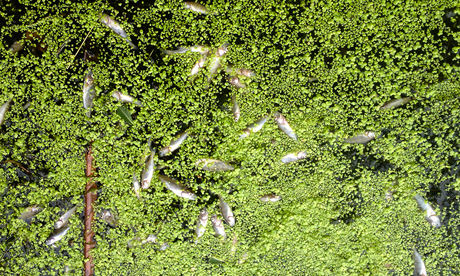River of death: storms and road pollution kill thousands of fish

Dead fish near Lea Bridge. Photograph: Dee O’Connell
The River Lea has been “pushed to its very limits” according to campaigners, after thousands of fish were found dead in the river this week.
Large numbers of fish have been found floating lifeless at various points along the river after storms washed road pollution into the waterway.
Scores of dead fish were seen to accumulate at Springfield Marina and the Lea Bridge Weir.
The Canal and River Trust, the body responsible for keeping the river open to navigation, said that they estimated the number of fish deaths to be in the thousands.
Recent warm weather depleted oxygen levels in the river, according to the Trust, with levels reduced further after heavy rainfall washed oil and other road pollution run-off into the river.
Run-off from driveways and misconnected drains are also thought to have contributed to the problem.
Leela O’Dea, an ecologist at the Canal & River Trust, said: “It’s tragic to see so many dead fish in the Lee. The hot weather of recent weeks and the surface water run-off following the storms have depleted oxygen levels in the river and the fish have suffered.”
The Trust set up an aerator at Lea Bridge Weir to increase oxygen levels in the water and provide a refuge area for fish.
Campaigners have said the design of the drainage system around the river is to blame, with nothing to prevent pollution flowing into the waterway.
Theo Thomas, co-ordinator of waterways charity Thames21’s Love Lea campaign, said: “The River Lea is a heavily polluted river. What this week’s storm starkly showed is that we’ve pushed the Lea to its very limit. Too many of East London’s roads drain straight to the river, washing pollution in every time it rains. Natural drainage is needed to clean the water before it reaches the river.”
Dee O’Connell, who lives in a house on the banks of the Lea in Hackney Wick said: “There were dead fish rotting outside my door – the smell of it turned my stomach.”
Ms O’Connell tests the river water for pollutants on a fortnightly basis, and said “I love the Lea Valley and I love the Lea, but at times it is just disgusting. People are boating, people are going down there in kayaks. Now that I’ve done the water testing, I actually wouldn’t do that, because doing the testing myself I’ve realised how polluted it is.”
The Environment Agency (EA) also set up an aerating unit lower down the Lea at Three Mills boatyard. A spokesperson for the EA said “Mechanically aerating the water has helped raise oxygen levels in the river, which crashed as a result of recent thunderstorms. This helped created a refuge area for fish such as bream, perch, pike and roach. Aeration equipment will be kept in as long as needed and until the unsettled weather clears.
“We have also been working in partnership with the Canal and River Trust, which has also been aerating along the river. Thanks to our quick response, our monitoring results show that oxygen levels are rising to between 20 per cent and 25 per cent and we will continue to monitor the situation throughout the day to ensure oxygen levels continue to improve.”
Robin Grey, a London boater said “Promises were made before the Olympics but things haven’t been done. Maybe too much attention is being paid to the area around the Olympic Park, when the problem is literally upstream.
“If this river were in a wealthier part of London, it wouldn’t be in the state it is in”.
Anyone who spots pollution or dying fish in the river is asked to call the Environment Agency on 0800 80 70 60.

It seems that there is the very real possibility that this may have been caused by changes made to the river as part of the Olympic developments, and that the opening of last weekend’s Anniversary Games may also have played a part.
As the “Olympic Legacy” continues to be fought over, perhaps some more investigation is called for?
“The Waterworks River, a part of the tidal Bow Back Rivers, has been widened by 8 metres (26 ft) and canalised to assist with construction of the Olympic Park for the 2012 Summer Olympics. In 2009, Three Mills Lock was installed on the Prescott Channel to maintain water levels on the Lea, within the park at a depth of 2 metres (7 ft). This will allow access by 350–tonnes barges to ensure that at least 50% of the material required for construction to be delivered, or removed by water. (These figures are under review. It is stipulated that the governing body has re appraised these figures)[8]”
From Wikipedia: http://en.wikipedia.org/wiki/River_Lea
http://www.newhamrecorder.co.uk/news/in_pictures_open_east_festival_wows_crowds_at_queen_elizabeth_olympic_park_1_2305083
http://www.theguardian.com/uk/2012/jul/24/olympics-changed-lower-lea-valley
“If this river were in a wealthier part of London, it wouldn’t be in the state it is in.”
The river Lea has been polluted for many years. It was once common to see animals, even a dog, in various stages of decay. Somehow, for me, this neglect never detracted from the Lea’s natural beauty.